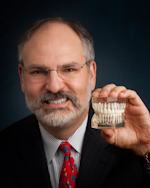This really is quite a riddle when you first read it. Let’s figure it out together, and it will make perfect sense.
Many times, I have tried to do something by myself only to realize that if I had someone’s help, it would be much easier. Having people who mesh and want to work together always makes the work easier. In previous articles, I have spoken about building the right team. There’s so much to that, but there is one small aspect that we can really unwind. It’s simple math.
More "Practice Building 101":
- Restoring your balance: It's not just about your patients
- Strategies for generating internal referrals
- You actually are the “I” in team
Staff buy-in
All of us are advised to have morning huddles, team meetings, and whole staff meetings. A CBS Sunday morning program called “Today’s agenda: Cutting down on meetings” aired in April 2023.1 The point of the segment was clear—we spend a lot of time in nonproductive meetings. Think about how excited you are coming back from a great conference. You call your team together and put forth the new idea that you learned from a practice management guru only to be met with blank stares. You might hear groans or murmuring, “He went to another meeting … it’ll pass.”
We’ve all been there, and we’ve learned the importance of buy-in when it comes to new ideas and methods of implementation. I want to break it down in the simplest of terms. This is why I came up the equation, “1 + 1 + 1 is 3 and 1 + 1 - 1 is only 1.” What does that really mean?
We all have friends in our lives, but how many times have you gone out with friends and left feeling totally depleted, perhaps even angry? You were looking forward to having a great evening at a wonderful restaurant, but from the moment you pick them up, the tension builds. You try to make small talk, being sure to avoid the topics of religion and politics, but the food comes late and nothing is correct, or there was nothing on the menu they wanted to eat. You and your spouse didn’t experience any of those things, but when you get in the car, the first thing you hear is, “I’m not going out with those people again.”
Are your staff additive or subtractive?
I want to be around people who add something to my life. When you’re at a meeting in any organization, it takes only one person to bring the whole team down. But the question is, what do you do about a toxic person? It’s hard to hire support people right now. Everyone is talking about the staff shortage and increased costs, and this leads to hesitation when it comes to firing toxic people.
You can try many things to save a staff member’s job, but if they are subtractive in your office and not additive, you need to let them go. I have been in the situation where I didn’t think I could fire an employee, but then it became clear that they were being subtractive, and my whole team was being brought down. I looked weak and other staff were saying, “Does he not see what’s happening?” The fact was, I chose not to see it because I was focused on patient care.
The math is simple. When you have one bad actor, the whole show can be ruined. So, what can you do and how do you do it? I believe the simple phrase, “Hire for attitude and train for excellence.” I also believe, “Hire slowly and fire quickly.” We use a 90-day probation period in our office, but we tend to know very quickly whether a hire is going to work out, and we must have the guts to do what’s necessary.
Do you have the fortitude to remove the toxic people in your personal and professional life? It’s difficult, but you aren’t alone, and you can do it because your practice’s health depends on it.
Editor's note: This article appeared in the November 2023 print edition of Dental Economics magazine. Dentists in North America are eligible for a complimentary print subscription. Sign up here.
Reference
- Rocca M. Today’s agenda: Cutting down on meetings. CBS News. April 16, 2023. https://www.cbsnews.com/news/todays-agenda-cutting-down-on-meetings/
Jeffrey C. Hoos, DMD, a 1978 graduate of the Tufts University School of Dental Medicine, started his private practice as a one-operatory walk-up and grew it to a four-doctor practice with 25 staff members. He lectures on innovative techniques that balance the art, science, and business of dentistry. He is one of the first general dentists to be Brånemark certified for implant placement, and his office has become a teaching center for restorative and implant dentistry. Contact him at [email protected].







